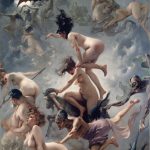René Magritte, born on November 21, 1898, in Lessines, Belgium, is celebrated as one of the most important surrealist artists of the 20th century. His work is known for challenging observers’ preconceived notions of reality, combining everyday objects in unusual contexts to create thought-provoking and often unsettling images. Magritte’s art explores the mystery and absurdity of the human condition, making the familiar strange and questioning the nature of perception and reality. This biography delves into the life, career, and enduring influence of René Magritte, whose unique vision and artistic courage opened new realms of possibility in the world of art.
Magritte’s early life was marked by tragedy; his mother’s suicide when he was just 14 years old profoundly affected him and would later be reflected in themes of loss, identity, and mystery throughout his work. He studied at the Académie Royale des Beaux-Arts in Brussels, where he began his career as a graphic artist and designer before turning to painting full-time.
In the 1920s, Magritte became involved with the Surrealist movement, connecting with other artists like André Breton and Paul Éluard. His work from this period demonstrates his growing interest in challenging reality and exploring the power of imagery and symbols. Magritte’s paintings often feature ordinary objects in an unusual context, forcing the viewer to reconsider their preconceived notions about reality. His technique was precise and meticulous, drawing on the influence of De Chirico’s metaphysical painting, yet his themes were deeply rooted in surrealism’s exploration of the subconscious and dreams.
One of Magritte’s most famous works, “The Treachery of Images” (1929), features a painting of a pipe with the caption “Ceci n’est pas une pipe” (This is not a pipe), highlighting the gap between language, the image, and the real object. This work encapsulates Magritte’s fascination with the limitations of representation and the inherent contradictions in art and perception.
Throughout the 1930s and 1940s, Magritte continued to develop his unique style, experimenting with motifs such as the bowler-hatted men, the hidden faces, and the juxtaposition of day and night in single scenes. His work from this period reflects a deeper engagement with the mysteries of existence, blending humor with a sense of disquiet and exploring themes of identity, reality, and illusion.
Magritte’s influence extended beyond the realm of visual art; his ideas and imagery have permeated popular culture, influencing advertising, film, and literature. His approach to surrealism—using it not just as a style but as a means of questioning the world—has inspired countless artists and thinkers.
After World War II, Magritte’s work became more recognized and celebrated internationally. He continued to explore and refine his themes and motifs, remaining prolific until his death in 1967. Unlike many of his contemporaries, Magritte chose to stay in Belgium for most of his life, drawing inspiration from its landscapes and urban environments.
René Magritte’s legacy is one of profound influence on the visual arts and beyond. His questioning of reality and the commonplace opened new avenues for artistic exploration, making him a central figure in the surrealist movement and a pivotal influence on postmodern and contemporary art. His work challenges viewers to see beyond the surface, to question their perceptions, and to recognize the complexity and ambiguity of the world around them.
Magritte’s art remains widely celebrated for its ability to transcend the ordinary, transforming everyday objects into sources of profound mystery and reflection. Through his innovative use of language, imagery, and symbol, Magritte has left an indelible mark on the art world, his unique vision and philosophical inquiries continuing to inspire and provoke. In exploring the boundaries between reality and illusion, Magritte’s work invites us to reconsider our own perceptions of the world, making him one of the most enduringly fascinating artists of the 20th century.






